

The global pandemic affected all of us in a way. Some positive, some negative.
And when it comes to customer success, it sure did a trick.
84% of customer success people say that customer success will go to offense mode from defense mode in the next 2 years.
This means that customer success won’t be about avoiding churn anymore.
We are now talking about better customer retention, more focus on value, and actual success of customers through better than ever strategies.
Not to mention that customer success is now officially mainstream.

When this is the current climate in SaaS customer success, it is important to check up on one’s knowledge on the topic.
Without further ado, let’s talk about customer success.
What is Customer Success?
Customer success is methods, strategies, and ways of getting your customers to achieve value with your product or service, rather than momentary satisfaction. Although it is not yet a fully structured concept, customer success teams still follow a relationship-based, proactive approach to solve customer pain points before customers even realize them.
All in all, customer success means making sure your customers are successful.
So that you can be successful.
Being a newly popularized term that was coined probably around 1996 and not by Salesforce a decade ago, the line between what is customer success and what isn’t seems to be blurry still.
Let’s fix that.
What isn't customer success?
If you have been in SaaS for long enough - around a week - you may have come across a misconception of customer support and customer service.
And even worse, between customer success and customer support/service.
That is, to say the least, wrong.
What’s the difference then?
Let’s clear up the misunderstanding once and for all.
Customer service/support and customer success are not the same thing.
Customer service is a business element present in all industries focused on solving customer problems before, during, and after purchase.
Customer support is a smaller, more specific type of customer service that is highly transactional, reactive, and problem-based.
Customer success, on the other hand, is a proactive, mostly non-transactional, and relationship-focused business element that deals with the entire customer lifecycle and the company’s own lifecycle.
But let’s break it down.
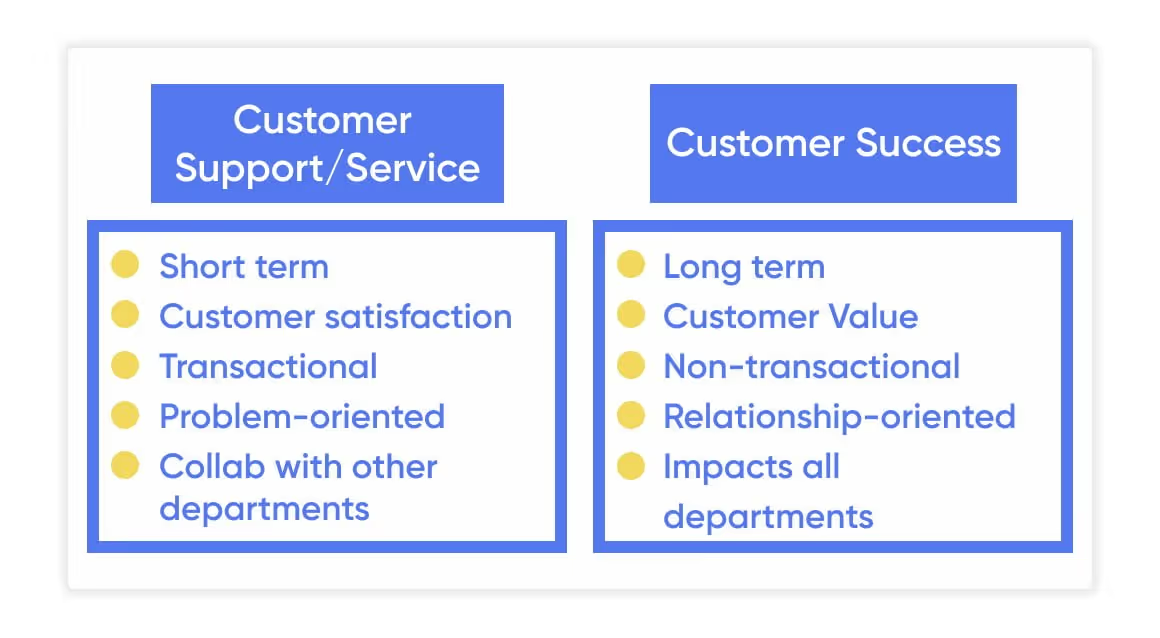
While customer service/support aims for customer satisfaction, customer success aims for value.
This means customer service/support can satisfy one customer at a time while customer success guarantees all customers’ satisfaction on a long-term basis.
And that is the difference between customer service and customer success.
But hey, why do we need customer success again?
Why do SaaS companies need customer success?
Let’s go over the basics.
What keeps a company in business?
Customers.
How do we acquire and retain customers?
By offering value.
How can we offer value to customers?
With customer success strategies.
It’s this simple. But let’s put it this way.
After a while in SaaS, I assume we all know that getting customers is easy.
What’s challenging is keeping them.
And what is even more challenging is keeping the retained customers so engaged in your product that they start talking about your product.
Now, adopting a customer success strategy won’t guarantee that customer acquisition, customer retention, user engagement, or word-of-mouth.
But it’ll surely make it a lot easier.
At the end of the day, what the SaaS world revolves around is revenue.
To achieve your revenue goals, you need acquisition, retention, engagement, and word-of-mouth.
And you need customer success for all of that.
What does a Customer Success Manager do in SaaS?
A customer success manager is the person who finds, initiates, and invests in customer success strategies in a company.
If Sherlock Holmes was a real person interested in SaaS, he’d be killing it as a customer success manager.
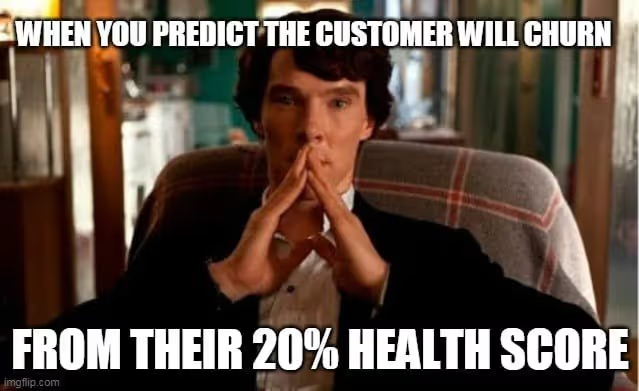
By looking into customer data and feedback, customer success managers seek to understand customer needs and expectations even before customers run into problems, or worse - churn.
But what exactly does a customer success manager do?
SaaS Customer Success Manager Responsibilities
I have said it once and I will say it again.
Customer success is not yet properly structured.
Consequently, customer success may mean many different things for many different companies.
However, at the end of the day, there are some responsibilities that a SaaS customer success manager usually has.
Here are some:
- Representing the customer in the company
- Bringing the departments together under the main goal
- Linking the customer service and sales
- Analyzing data to take calculated steps
- Proactively overseeing all customer relations
- Looking for ways to promote and improve brand/product/service
And what about skills?
SaaS Customer Success Manager Skills
Remember when I said customer success is getting more and more popular?
Naturally, it’s getting more competitive too.
And if you are just getting into customer success, there are some skills you must have to make sure you take the spotlight next to your competition.
These skills are:
✅ Communication skills - as customer success teams have to be in touch with almost all departments of a company as well as the customers, it goes without saying that there is a need for strong communication skills as a CSM
✅ Problem-solving skills - Customer success is all about making sure the customers are successful using the product and that they don’t run into problems. However, to achieve this, CSMs must first be able to solve the problems themselves.
✅ Observation skills and empathy - Strong observation skills are what make up the technical parts of customer success. Moreover, it is near impossible to predict potential problems without empathy for the customer.
✅ Leadership skills - It is not rare that a CSM finds himself/herself in a leadership position. And even when the CSM isn’t the leader, he/she must still be confident and supportive toward other employees to make sure the customer success strategies resonate with everyone.
✅ Relationship-building skills - Customer success is a relationship-based phenomenon. Even when it is non-transactional, CSMs have to indirectly build solid relationships with customers through the product.
✅ A keen eye for trends in the industry - Customer success trends are ever-changing, especially in the post-pandemic world. To successfully have customers succeed, CSMs must always look out for new trends and be open to improvement. As customer success grows in practice, so do the customer success people together.
✅ Nerves of steel - Customer success can be anything, but it’s no walk in the park. If you want to play it big, you must have the ambition to read, write, research, think, and build customer success non-stop. Sure, it gets stressful. But it’s nothing compared to the feeling when you get positive results.
SaaS Customer Success Career Path
An interesting fact here.
Did you know that the gender distribution for customer success managers is almost equal with 47.2% male and 48.2% female?
But still, this is true for customer success managers, not all titles.
Women dominate entry-level positions while men are the majority in higher positions.
And what are those positions?
Let’s take a look.
Customer Success Roles
Customer success associate - Although it is often named differently depending on the industry or the company, customer success associate is the entry-level position for customer success.
Customer success manager - The most populated of all customer success positions, customer success manager is the title given to a regular member of a customer success team or the leader of entry-level employees in bigger teams.
Senior customer success manager - mostly present in bigger companies, a senior customer success manager is someone who is generally in charge of CSMs and/or customer success associates.
Director of customer success - not just a higher position on the chain, a director of CS is someone who builds the customer success team and mentors each CSM or senior CSM.
VP of customer success - Don’t mind the VP part, this title has basically the same responsibilities as the director of CS. However, a VP of customer success is someone closer to the executive branch of the company while a director of CS works closer to the CS team.
Chief Customer Officer - A position rarely present in small companies, a chief customer officer or a CCO is basically the CEO of customer success.
There are actually a couple more positions, hope you don’t mind taking a look at our customer success career path article 😁
Hey, but customer success people don’t just use their brains and a piece of paper, do they?
Let’s take a look at some of the best customer success tools for SaaS.
Customer Success Tools for SaaS
Customer success managers sure do deal with a lot of tasks.
They review feedback, check customer health scores, analyze data, lead campaigns and do a lot more industry-specific work.
And they cannot do all that on an excel spreadsheet.
Here are some customer success tools that make it easier for CSMs.
1- Custify
Custify is a customer success automation tool for B2B SaaS platforms to reduce churn and increase customer lifetime value, offering an intuitive and user-friendly interface.
The concierge onboarding and automation features put Custify in a unique position on the market.
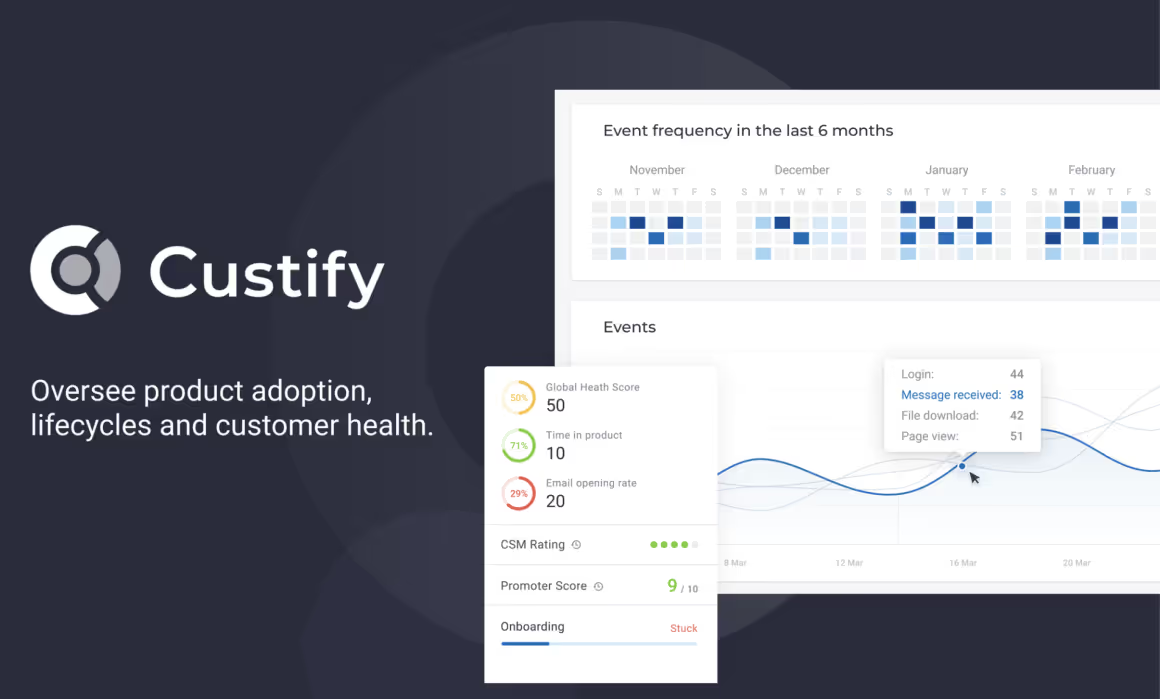
Custify’s greatest strengths are the personalized onboarding process and the automation features. Within its modern interface, you can set up multiple health scores to track and determine their weight on the global account health score. With the playbooks feature, you can set up automation such as creating and assigning tasks to CSMs, sending personalized messages, or triggering custom actions.
Tracking customer lifecycles is particularly easy in Custify because of the friendly interface, and we appreciate the option to add custom CSM ratings. The platform makes it easy to track customer success, its features focus on the fact that each customer's behavior is different.
Best Features
- Playbooks and automation
- Concierge onboarding
- Multiple configurable health scores
- 360 view of the customer
- Automated task management
- Custom CSM ratings
Pricing
- Starter: $199/month up to 2 users
- Standard: $499/month up to 5 users
- Enterprise: quote-based
2- Totango
Coming to the rescue for small businesses and startups, Totango’s customer success tool Spark is one of the most affordable CSM tools often praised for its features like customer segmentation and third-party tool integrations.
Trusted by Zoom, NTT, and SAP, Spark might be what you need with its minimalistic interface and strong features.
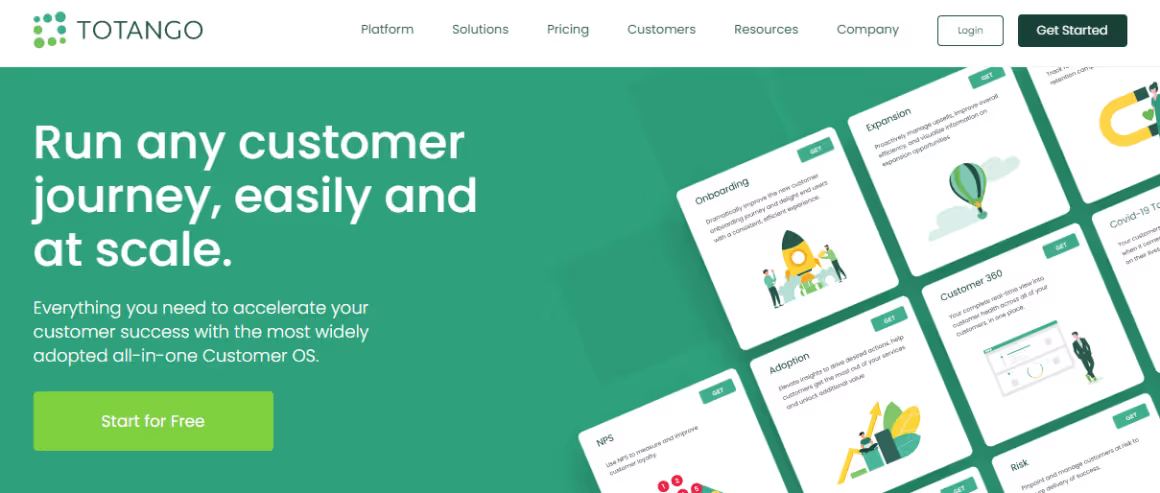
3- ChurnZero
Among the highest-rated customer success tools on G2 and Capterra, ChurnZero sure is a fan favorite.
With so many cool features like task automation and customer monitoring, and ease-of-use as its forte, ChurnZero is just right for medium to bigger companies.

4- Gainsight
Gainsight really does help you gain sight.
With powerful features like customer health score tracking, NPS score tracking, and customer history monitoring, Gainsight takes customer success seriously.
And helps CSMs gain sight of it in an easy way.
Best for bigger and enterprise-level companies, Gainsight is the leader of customer success software.
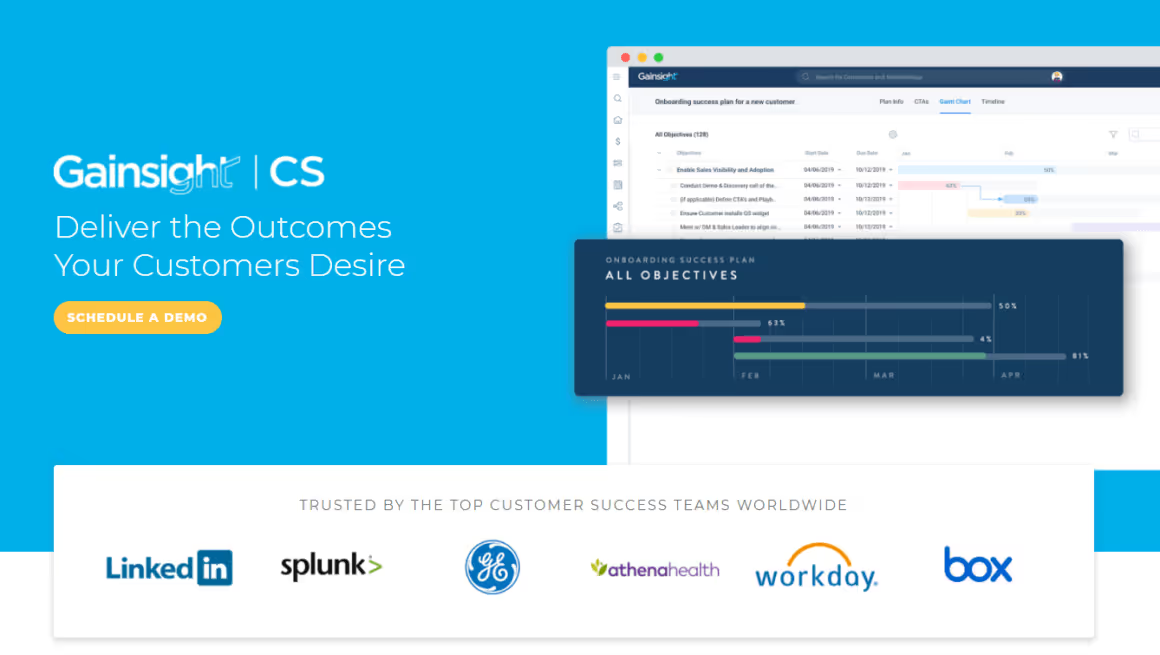
Here are 11 more customer success software we think you need to adopt.
Isn't there a tool for user onboarding too?
Yes, there is.
And you absolutely need it.
Imagine this.
You are a new user in a website or app and you can’t wait to use it.
You log in and of course, subconsciously, you expect a product tour, some tooltips, or even a tiny little hotspot.
And there is none.

And the worst part is, you don’t actually realize you needed all that until you notice it is missing.
That is one big blow to customer success right off the bat.
As I mentioned previously, user onboarding has been gaining more recognition from the customer success people, and it is for a good reason.
We are all used to phrases like “around the customer lifecycle” and “proactive” or “relationship-based” when talking about customer success. But it is just self-contradictory when user onboarding is overlooked.
So I recommend all CSMs and CSMs of the future to focus more on user onboarding and less on churn rates.
Trust me, you won’t have to deal with the churn rates once you handle that onboarding 😏
“And how do I do that?” I can hear you asking.
You have two options: code it in-house, or use no-code tools.
And if you asked me, I’d be totally on board with no-code onboarding tools, like our very own UserGuiding.
With UserGuiding you can:
✅ create seamless user onboarding flows,
✅ initiate product tours, checklists, and interactive guides,
✅ create NPS surveys,
✅ and launch a resource center, our newest addition to the tool shack!
Remember, for a good CSM, everything is a new opportunity, and all these onboarding opportunities for better customer success are just a click away. 👈
Customer Success Metrics for SaaS
We got the CSMs and we got the CS tools, but here’s another question.
How does one measure success?
Customers don’t just come up to CSMs and say “hey, I feel successful with this tool, Thought you might want to know.”
In fact, for every one customer complaining, there are 26 other unhappy customers that don’t.
Instead, they churn.
And to avoid that CSMs need insightful customer success metrics that will let them know before it comes to that.
Here are my favorite three.
1- Customer churn rate
Perhaps one of the most obvious metrics is customer churn rate (aka customer attrition rate).
By applying customer churn rate, you get a clear picture of churn in a given period of time. Some indicators of customer churn are:
- Customers canceling subscriptions
- Customers deleting accounts
- Loss of recurring contract
- Loss of recurring value
And the formula is pretty easy.
The total number of churned customers / total number of all customers = Customer Churn Rate
Although customer churn rate doesn’t seem like much, it is the fundamental metric that affects customer success decisions, as well as more complicated metrics.
2- Net Promoter Score (NPS)
While customer churn rate deals with what is lost, the net promoter score focuses on what might be lost and what might be gained.

NPS measures customer satisfaction and loyalty and is a great way to detect possible churns. According to what the customers answer to your NPS survey, they are distributed into 3 groups:
- If the customers give you 0-6, they are detractors,
- If the customers give you 7-8, they are passives,
- If the customers give you 9-10, they are promoters.

With the data from the survey, you can now calculate your NPS.
The percentage of promoters -(minus) percentage of detractors = NPS
Essentially, what you’re trying to do is keep the customers from being detractors and encourage them to be promoters to keep your NPS score as high as possible.
Note here that an NPS of 50 is good while 70 is considered world-class.
Also note that you can easily create an NPS survey with UserGuiding. Wanna try?
3- Customer Health Score
This one is probably my favorite.
So, we have customer churn rate which is essentially the simplest calculation you can do.
Then there is the net promoter score which focuses on what the customers have to say about you.
Then we have the customer health score which focuses not only on data and feedback but behavior.
There are many smaller metrics for customer health scoring and that is what makes it so reliable and easier to predict the customers’ next move.
Among these metrics are:
- Frequency: How much time do users spend on your product?
- Breadth: How many users in a specific account are using the product?
- Depth: How many of your product’s key features are being used?
And many more.
Moreover, you can look into customer growth and history through customer health scoring, which is a must to retain customers.

SaaS Customer Success Best Practices
Customer success is not well established. Sure, we know.
But this doesn’t mean there are no best practices or trends.
Let’s look at the best practices and latest trends that are fundamental for any SaaS customer success team.
1- Know what success is
You cannot guarantee value without knowing what value is.
And as you might have already noticed, success is mostly business-specific.
What is success for one company may be a failure for another.
A customer success manager or any other customer success professional has the very primary responsibility of figuring out what success means for their customers.
For example, for a restaurant, customer success could mean customers enjoying a meal and coming back the next day.
For retail, it could mean customers purchasing an item without any trouble.
And for a SaaS company, customer success could mean having the customers use more and more features every day or decide to upgrade.
Although it looks like a small task, by deciding what customer success means for the specific company and its customers, customer success teams start off the right way and avoid going a completely different direction.
2- Know your data and metrics
Success is no technical work.
In fact, it is more close to psychology than it is to science or tech.
So why the constant emphasis on data and metrics?
Because you cannot make predictions on customer behavior without a solid base.
In our online event last March, we had Swiftly senior VP of customer success Maranda Dziekonski as a guest speaker, and what she had to say on the issue resonated with me on a personal level.
“I don’t think we can get around customer success managers not looking at data anymore. For us to truly understand customer behavior, anticipate needs, and be more proactive, we have to be comfortable with being able to shlock through the data.”
Maranda Dziekonski, Swiftly, Senior VP of customer success
So, it is clear to see.
In the current climate of customer success, customer success managers cannot just be good presenters or have good relationships with customers.
Critical thinking is key.
3- Have a comprehensive customer journey map
We have already discussed that customer success is a company-wide set of ideas and strategies.
And when you have the whole company working on one big project there is miscommunication, there is chaos, and there are mistakes.
To avoid that, customer success teams must create a comprehensive customer journey map that will cover all touchpoints from signup to upsell - or churn.

Moreover, a customer journey map is basically a document that covers everything done in the name of customer success.
The data from interviews, feedbacks, reviews, CS tools, team decisions, and KPIs can all take place in the customer journey map; or you can just come up with the simplest template which can still keep you on track.
As long as there is a document or tool that will help keep track, you are good to go.
Customer success people are human too, you know?
4- Keep onboarding high-touch and less annoying
For the longest time, onboarding processes had been overlooked by customer success.
There was this belief that customer success was all about what happens after the initial introduction to the product or service.
But today, CSMs finally realize that onboarding is also a part of the customer journey.
And they are in it to make it better.
“If you start the customer journey out rocky, the rest of the journey is going to be difficult. It is important to remember that renewal starts at the sale which is generally where the onboarding starts.”
Maranda Dziekonski, Swiftly, Senior VP of customer success
Onboarding went through many changes thanks to current trends, and I must admit that customer success had a great role in that. More and more companies are realizing that a user manual won’t do the job.
So now, we are stepping into the territory of high-touch, less annoying onboarding.
With bite-size product tours, no more forced tooltips, and highly personalized guides, you can tell that customer success teams had an impact.
And if enough people will pick on this best practice, we are bound to have more coming our way.
5- Be in touch with your customers
A common mistake made way too often for the current time and age, customer success teams tend to calculate in one thing.
The customers.
It is of course very natural to be overwhelmed by the amount of data to analyze, metrics to apply, and strategies to implement in the whole company.
But we have to acknowledge that a personal email or a phone call you will have with your top customers can go a long way.
A longer one than just coding their names in the tooltips.
The most important customers might need checking on several times a week while other top customers would be good with once a week. And throughout your user base, it wouldn’t kill you to check up on them once a month, would it?
So today, make sure you plan a personalized emailing system or phone calls with your customers.
What they might not be saying on the NPS surveys could find their way through to you.

3 Tips to Increase Engagement with Customer Success in SaaS
No properly structured way of practice, a workflow covering almost all departments of the company, and being responsible for the whole lifecycle of the customers.
Customer success sure is hard.
But don’t worry. I have just the thing for you.
Here are three very simple tips to increase engagement with customer success in SaaS.
1- Utilize the right tools and resources
It is way too often that we see companies suffer from a lack of a proper set of tools or worse- the wrong tools.
And in our case, it might be a customer success tool that is lacking or just not matching the team goals.
To avoid such problems, there are a couple of things to remember when opting for a customer success tool.
What to look for in a CS tool?
- Metrics integration: your company might not be looking into some metrics or the most important metrics to look into might not be present in some customer success tools. It is best to have a detailed look into specific metrics you can monitor on the software before purchasing it.
- Size of the user base: some tools are naturally for bigger user bases while others provide a more detailed look into a smaller user base. It is in the nature of the software. To avoid being stuck with too few details or capacity for fewer users, one must check how the tool can handle the user base.
- Third-party tool integration: Customer success managers work with a lot of different teams and departments. Consequently, the CS tool must be able to catch up with that. The more integration, the more insight on customer success.
Then, there is the resources part. According to Amanda Dziekonski, it is among the latest trends in customer success that customer success teams get more access to the budget.
Or at least they don’t have to fight for it anymore.
And at the end of the day, it is in the customer success team’s initiative that the money goes to the right places.
Keep in mind that a lot more is expected from customer success now that many companies have seen rock bottom.
A good return will be expected for every investment.
2- Turn everything into a success opportunity
To offer value to your customers, you first have to see the value yourself.
And that is one customer success manager superpower that I think is the backbone of customer success.
Seeing everything as an opportunity.
Here is a snippet of how a customer success manager’s brain works.
👉There is a website visitor visiting for the second time in a week.
A CSM sees it as an opportunity to make an offer to turn their interest into a subscription.
👉A customer has suddenly started using more features.
A CSM sees it as an opportunity to offer an upgrade to the customer’s plan.
👉A customer shows signs of churning and shows no interest in coming back.
A CSM sees it as an opportunity to get feedback from the eyes of a detractor and possibly make an offer.
No company has non-stop customer acquisition and all companies have churning customers. What matters is whether you can use these circumstances to leverage your other customers’ success or not.
3- Invest in education
Be it user education or employee education, it is clear that we need education.
With the increasing popularity of customer success, there is a huge influx of new people in the field.
And that calls for drastic measures.
Such as educating new employees wisely; making sure they have a clear understanding of what success looks like, what metrics they need to figure it out, and what tools can help them.
And while you are at it, educate yourself, the team, and the rest of the company too. Learning never ends, and your chances of better success are higher if you can align the whole company.
Conclusion
Customer success is improving, developing, and getting more popular every day.
With the changing business climate, one cannot unsee the importance of understanding customer behavior. Furthermore, the rising access to budgets by customer success teams shows just how much SaaS companies care about better customer success strategies.
So are you going to trust the traditional ways of customer retention or catch up with customer success trends?
Either way, let this article guide you. Great things are bound to happen soon.
Frequently Asked Questions
What is Customer Success in SaaS?
Customer Success in SaaS is defined as a mindset and compilation of strategies to help customers get value out of a product or service.
What makes SaaS customer success different from customer success in other industries and fields is that it revolves around a digital user experience that requires more intuition and critical thinking skills on the customer success team side.
Why is customer success important for SaaS?
What makes customer success so important for SaaS companies is that in SaaS there are multiple elements of business elements unique to or especially crucial for subscription-based businesses such as customer retention, customer engagement, word-of-mouth, and customer loyalty. To make sure all these business factors function right, customer success is an important and necessary process.
Is customer success part of sales?
One of the most unique and beneficial sides of customer success is that it is a company-wide mindset. Although the customer success team can be a part of the sales department, the marketing department, or the customer service department in different companies, customer success teams essentially work with the entirety of the company. By coming up with customer success strategies, a customer success team may have an influence on every department.
What is the meaning of “SaaS customer success”?
SaaS customer success is a term used for customer success specific to the field of SaaS. Although the job description can be essentially similar to other customer success roles in other industries, a SaaS customer success manager generally has various responsibilities unique to SaaS, such as user onboarding success tracking, customer history monitoring, and customer health score tracking.

















.svg)
.svg)
.svg)
.svg)
.svg)

.svg)
.svg)












.svg)
.svg)




.png)

















